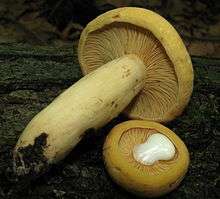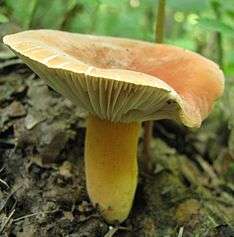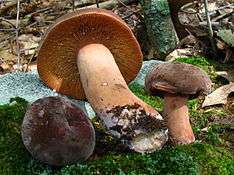Lactifluus volemus
Lactifluus volemus, formerly known as Lactarius volemus, is a species of fungus in the family Russulaceae. It is widely distributed in the northern hemisphere, in temperate regions of Europe, North America and Asia as well as some subtropical and tropical regions of Central America and Asia. A mycorrhizal fungus, its fruit bodies grow on the ground at the base of various species of trees from summer to autumn, either individually or in groups. It is valued as an edible mushroom, and is sold in markets in Asia. Several other Lactifluus mushrooms resemble L. volemus, such as the closely related edible species L. corrugis, but these can be distinguished by differences in distribution, visible morphology, and microscopic characteristics. L. volemus produces a white spore print and has roughly spherical spores about 7–8 micrometres in diameter.
The colour of the L. volemus mushroom varies from apricot to tawny, and the cap may be up to 11 cm ( 4 1⁄2 in) wide. The pale golden yellow gills on the underside of the cap are closely spaced and sometimes forked. One of the mushroom's most distinctive features is the large amount of latex ("milk") that it exudes when the gills are damaged, leading to the common names weeping milk cap and voluminous-latex milky. It also has a distinctive fishy smell, which does not affect the taste. The fruit bodies have been chemically analysed and found to contain several sterols related to ergosterol, some of which are unique to this species. The mushroom also contains a natural rubber that has been chemically characterized. Phylogenetic analysis suggests that Lactifluus volemus represents several species or subspecies, rather than a single taxon.
Taxonomy and naming
The first mention of Lactifluus volemus in the scientific literature was in Carl Linnaeus's 1753 Species Plantarum, under the name Agaricus lactifluus.[4] In 1821, Swedish mycologist Elias Magnus Fries called it Agaricus volemus in his Systema Mycologicum.[5] In this work he proposed a grouping of related species (called a tribus, or tribe) within the genus Agaricus, which he named Galorrheus. Fries later recognised Lactarius as a distinct genus in his 1838 Epicrisis Systematis Mycologici, citing Galorrheus as a synonym.[1][6] Although Linnaeus had published the species before Fries, Fries's name is sanctioned and thus has nomenclatural priority. In 1871 Paul Kummer raised most of Fries's tribes to generic rank, and so renamed the species Galorrheus volemus.[7] The variety L. volemus var. subrugosus was identified by Charles Horton Peck in 1879,[8] but is now classified as a separate species, L. corrugis.[9] In 1891, Otto Kuntze moved the species into Lactifluus,[10] which was afterwards long considered a synonym of Lactarius but confirmed as a separate genus through molecular phylogenetics in 2008 and subsequent taxonomical rearrangements within the family Russulaceae.[11][12][13]
Another historical synonym is Lactarius lactifluus, used by Lucien Quélet in 1886,[14] a renaming based on Linnaeus's Agaricus lactifluus. Lactarius wangii, reported by Hua-An Wen and Jian-Zhe Ying to be a new species from China in 2005,[15] was synonymised two years later with L. volemus.[3]
The specific epithet "volemus" is derived from the Latin vola,[16] meaning "the hollow of the hand", suggestive of Fries's reference to the large amount of latex "flowing enough to fill the hand".[17] Common names for L. volemus include the weeping milk cap,[18] the tawny milkcap,[19] the orange-brown milky,[20] the voluminous-latex milky,[21] the lactarius orange,[22] the fishy milkcap,[23] and the apricot milk cap. In the West Virginian mountains of the United States, the mushroom is called a "leatherback" or a "bradley". The latter name may originate from its German name Brätling.[24][25]
Phylogeny
| ||||||||||||||||||||||||||||||||||||||||||||||||||||||||||||
| Phylogeny of the Lactifluus volemus group based on large subunit rDNA sequences. L. volemus and L. corrugis specimens are distinguished based on differences in colour or distribution: A-1, velvet type; A-2 red type; A-3, Chinese type; B-1, red type; B-2, common type; C-1, common in Japan; C-2, yellow type.[26] |
Lactifluus volemus was the type species of the section Dulces in subgenus Lactarius, and is currently classified in Lactifluus section Lactifluus.[27] The group around this L. volemus includes species with a dry cap, abundant latex, and a white or pale cream spore print.[28] Because the closely related L. corrugis has overlapping morphological characters, including similar colouration in the cap and stem, it has been difficult to reliably distinguish between the two species. The difficulty in discerning the two is exacerbated by the fact that both species have several colour forms: Japanese specimens of L. volemus may have a red cap, a yellow cap with a long stem, or a velvet-like surface texture; the caps of L. corrugis may be either red, commonly rust-coloured. In 2005, Japanese researchers clarified the relationships between these two species and others in section Dulces using molecular phylogenetics, and by comparing differences in fatty acid composition, morphology, and taste. The colour variants group phylogenetically into different subclades, suggesting that they might better be considered as "different species, subspecies, or varieties".[26] A 2010 molecular study of L. volemus of northern Thailand found that 79 tested specimens could be divided into 18 distinct phylogenetic species; six of these were described as new species: Lactifluus acicularis, L. crocatus, L. distantifolius, L. longipilus, L. pinguis and L. vitellinus.[29]
Description
Macromorphology
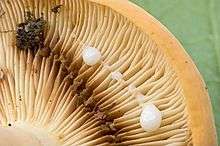
The fruit body of Lactifluus volemus has a fleshy and firm cap with a velvety or smooth surface and a shape that changes with maturity: it starts off convex, with edges curved inwards, then later grows flat with a depression in the middle. With a typical diameter of 5 to 11 cm (2– 4 1⁄2 in), its colour ranges from apricot to tawny.[30] The cap colouration, however, is somewhat variable, as has been noted in Asian,[3] European,[31] and North American specimens.[2] The stem, whose height varies between 4 and 12 cm ( 1 1⁄2 and 5 in), and which is typically between 1 and 1.5 cm (0.4 and 0.6 in) thick, has a slightly lighter colouration than the cap. It is firm, with a velvety or smooth surface that sometimes has depressions running longitudinally up and down its length. The gills are adnate to slightly decurrent, brittle, narrow, quite closely spaced and sometimes forked. Normally a pale golden yellow colour, the gills turn brown when bruised. Interspersed between the gills are lamellulae, short gills that do not extend to the stem. The flesh is whitish and firm. The mushroom smells somewhat fishy;[30] one source suggests the odour is "like a dead shad, which anglers will tell you is probably the most malodorous freshwater fish".[32] The odour is concentrated when the fruit bodies are dried. One of the mushroom's most distinctive features is the abundant latex, so plentiful that a small nick on the gills will cause it to "weep" the milky substance.[18] The latex tends to impart brown stains on whatever it contacts.[32]
Micromorphology
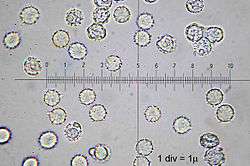
The spore print is whitish. The spores are roughly spherical, translucent (hyaline), and typically measure 7.5–10.0 by 7.5–9.0 µm.[33] The spore surface is reticulate—covered with ridges that form a complete network. The ridges are up to 0.8 µm high and have conspicuous projections up to 1.2 µm high. The spore-bearing cells of the hymenium, the basidia, are club-shaped, hyaline, four-spored, and have dimensions of 40–62 by 7.2–10.4 µm.[34] Interspersed among the basidia are sterile cells called cystidia. The pleurocystidia (cystidia on the side of a gill) are roughly spindle- to club-shaped, and measure 48–145 by 5–13 µm. The cheilocystidia (cystidia on the edge of a gill) may be spindle-, club-, or awl-shaped (subulate), or intermediate in between these forms, and measure 27–60 by 5–7 µm.[2] Additionally, there are cystidia present on both the surface of the cap and the stem.[30] If a drop of ferric sulphate (used as a chemical test in mushroom identification) is applied to the mushroom flesh, it will immediately stain dark bluish-green.[33]
Varieties
The variety Lactifluus volemus var. flavus was described by Alexander H. Smith and Lexemuel Ray Hesler in their 1979 monograph of North American Lactarius species.[2] This rare variety, found in the southeastern United States (ranging from South Carolina to Florida and extending west to Texas), has a cap that stays yellow throughout its development. It also has slightly smaller spores than the regular variety: 6.5–9.0 by 6–8 µm.[33] Some authors have considered the rarely collected L. volemus var. oedematopus, found in central and southern Europe, to be a distinct variety distinguished from the common variety by a darker reddish-brown cap and a swollen stem. This assessment is not universally accepted, possibly because it falls within the range of morphological variation shown by the main variety.[35] L. volemus var. asiaticus was named in 2004 based on Vietnamese specimens; associating with Khasi pine (Pinus khasya), it has small, dull brown, velvety fruit bodies.[36] In general, little taxonomical significance has been ascribed to the several varieties of L. volemus that have been proposed.[29]
Similar species
Lactifluus volemus is closely related to L. corrugis, and generally similar in appearance. L. corrugis usually has more surface wrinkles, darker gills, weaker or absent scent, and less orange colouration; however, intermediate colour forms can be found.[9] The two can be distinguished more definitively by microscopic characteristics: L. corrugis has larger spores—typically 10.4–12.8 by 9.6–11.8 µm—with a coarser surface reticulum, and larger pleurocystidia.[34] The species Lactifluus austrovolemus is closely related, but has more crowded gills, while L. lamprocystidiatus can only be reliably distinguished from L. volemus by microscopic characteristics: the reticulations on its spores are taller and more acute, and the meshes formed by the intersections of the reticulations are smaller.[3] Both L. austrovolemus[37] and L. lamprocystidiatus[38] are known only from Papua New Guinea. Lactifluus hygrophoroides also resembles L. volemus, but differs in having widely spaced gills, and spores that lack surface reticulations.[39]
Some species of the genus Lactarius are also similar: The tropical African Lactarius chromospermus has a superficial resemblance to L. volemus, but the former species, in addition to its African distribution, can be identified by its cinnamon-brown spore print—unique in the Russulaceae.[40] Lactarius subvelutinus is also similar to L. volemus, but lacks the fishy odour, has a dull yellow-orange to bright golden orange cap, narrow gills, and a white latex that does not change colour.[33]
Edibility and other uses
| Nutritional value per 100 g (3.5 oz) | |
|---|---|
| Energy | 1,631 kJ (390 kcal) |
|
64 g | |
|
4 g | |
|
25.2 g | |
| Minerals | |
| Iron |
(12%) 1.5 mg |
| Manganese |
(67%) 1.4 mg |
| Zinc |
(35%) 3.3 mg |
| |
|
Percentages are roughly approximated using US recommendations for adults. Source: USDA Nutrient Database | |
Despite the unappealing fishy scent that develops after the mushroom is picked,[42] Lactifluus volemus is edible and recommended for culinary usage, though, typical of milk caps, it has a slightly granular texture that some may find unappetizing.[18] The odor disappears during cooking.[43] The latex only has a mild taste.[30] The species is considered good for novice mushroom hunters to eat,[17] and is best prepared by slow cooking to prevent it from becoming too hard;[42] specimens that have been rehydrated after having been dried will require longer cooking times to eliminate the grainy texture.[43] The mushroom has also been suggested for use in casseroles and thick sauces.[44] Pan frying is not a recommended cooking technique, due to the large amounts of latex it exudes.[42] L. volemus is one of several species of milk caps that are sold in rural markets in Yunnan Province, China,[45] and it is among the most popular wild edible mushroom species collected for consumption and sale in Nepal.[46] In their 2009 book on milk caps of North America, Bessette and colleagues consider the mushroom "the best-known and most popular edible milk mushroom" in the eastern United States.[25] A Turkish study of the nutritional composition of the fruit bodies concluded that L. volemus is a good source of protein and carbohydrates.[41]
Bioactive compounds

Fruit bodies contains a unique sterol molecule called volemolide, a derivative of the common fungal sterol ergosterol that may have application in fungal chemotaxonomy.[47] A 2001 study identified a further nine sterols, three of which were previously unknown to science. According to the authors, these types of highly oxygenated compounds—similar to sterols found in marine soft coral and sponges—are rare in fungi.[48] The mushroom also contains volemitol (D-glycero-D-mannoheptitol), a seven-carbon sugar alcohol first isolated from the species by the French scientist Émile Bourquelot in 1889.[49] Volemitol occurs as a free sugar in many plant and brown algal species.[50]
Due to their natural polyisoprene content (1.1–7.7% by dry weight of fruit bodies),[51] L. volemus fruit bodies can also be used to produce rubber.[52] The chemical structure of rubber from the mushroom consists of a high molecular mass homologue of polyprenol, arranged as a dimethylallyl group, two trans isoprene units, a long sequence of cis isoprenes (between 260–300 units), terminated by a hydroxyl or fatty acid ester.[53] Biosynthetically, the creation of the polyisoprene begins with the compound trans,trans-farnesyl pyrophosphate, and is thought to terminate by esterification of polyisoprenyl pyrophosphate.[51] The enzyme isopentenyl-diphosphate delta isomerase has been identified as required for the initiation of rubber synthesis in L. volemus and several other milk cap species.[54]
Ecology, distribution, and habitat
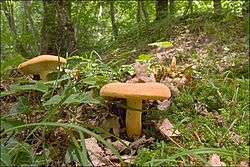
Like all milk caps,[55] L. volemus forms ectomycorrhizae, mutually beneficial symbiotic associations with various tree species. In this association, the fungal hyphae grow around the root of the plant and between its cortical cells, but do not actually penetrate them. The hyphae extend outward into the soil, increasing the surface area for absorption to help the plant absorb nutrients from the soil. It is found growing at the base of both coniferous and broad-leaved trees, although it is more common in deciduous woods. It may also sometimes be found in peat moss beds. The fruit bodies, which appear between summer and autumn, are common.[2] They can be found growing solitarily or in groups, and are more abundant in weather that is warm and humid.[17]
Fruit bodies can be inhabited by species of limoniid flies, such as Discobola marginata or Limonia yakushimensis, as well as several species of fungi-dwelling mites. The flies are hosts for the mites in a symbiotic association known as phoresis, whereby the mites are mechanically carried by its host. Mites are small and unable to migrate the relatively long distances between mushrooms without assistance; the insect hosts, in comparison, are large and can transfer the mites between their preferred feeding habitats.[56]
Lactifluus volemus is found in warm temperate regions and as well as some subtropical and tropical regions of the Northern Hemisphere. The fungus is widely distributed throughout Europe,[26][57] although it is in decline in some countries, and has become rare enough in the Netherlands (and Flanders) to be considered locally extinct.[23] In the Americas, the northern limit of its distribution reaches southern Canada east of the Great Plains,[58] and the species extends south to the East Coast of the United States[18] and Mexico, and beyond into Central America (Guatemala).[34] It is also known from Asia, including China (Qinling Mountains,[59] Guizhou Province,[3] and Yunnan Province[45]), Japan, India,[60] Korea,[61] Nepal,[46] and Vietnam.[36] Collections have also been made from the Middle East, including Iran[62] and Turkey.[41]
See also
References
- 1 2 "Species synonymy: Lactarius volemus". Species Fungorum. CAB International. Retrieved 2010-03-27.
- 1 2 3 4 5 Hesler LR, Smith AH (1979). North American Species of Lactarius. Ann Arbor, Michigan: The University of Michigan Press. pp. 162–66. ISBN 0-472-08440-2.
- 1 2 3 4 5 Wang X-H. (2007). "Type studies of Lactarius species published from China". Mycologia. 99 (2): 253–68. doi:10.3852/mycologia.99.2.253. PMID 17682778.
- ↑ Linnaeus C. (1753). Species Plantarum (in Latin). 2. Stockholm, Sweden: Impensis Laurentii Salvii. p. 1172.
- ↑ Fries EM. (1821). Systema Mycologicum (in Latin). 1. Lund, Sweden: Ex Officina Berlingiana. p. 69.
- ↑ Fries EM. (1838). Epicrisis Systematis Mycologici, seu Synopsis Hymenomycetum (in Latin). Uppsala, Sweden: Typographia Academica. p. 344.
- ↑ Kummer P. (1871). Der Führer in die Pilzkunde [The Mycological Guide] (in German) (1 ed.). p. 127.
- ↑ Peck CH. (1885). "New York species of Lactarius. Report of the State Botanist (for 1884)". Annual Report of the New York State Museum. 38: 111–33.
- 1 2 Roody WC. (2003). Mushrooms of West Virginia and the Central Appalachians. Lexington, Kentucky: University Press of Kentucky. p. 86. ISBN 978-0-8131-9039-6.
- ↑ Kuntze O. (1891). Revisio Generum Plantarum (in Latin). Leipzig, Germany: A. Felix. pp. 856–57.
- ↑ Buyck B, Hofstetter V, Eberhardt U, Verbeken A, Kauff F (2008). "Walking the thin line between Russula and Lactarius: the dilemma of Russula sect. Ochricompactae" (PDF). Fungal Diversity. 28: 15–40.
- ↑ Buyck B, Hofstetter V, Verbeken A, Walleyn R (2010). "Proposal to conserve Lactarius nom. cons. (Basidiomycota) with conserved type". Taxon. 59: 447–453.

- ↑ Verbeken A, Nuytinck J (2013). "Not every milkcap is a Lactarius" (PDF). Scripta Botanica Belgica. 51: 162–168.
- ↑ Quélet L. (1886). Enchiridion Fungorum in Europa media et praesertim in Gallia Vigentium (in Latin). Paris, France: O. Doin. p. 131.
- ↑ Wen HA, Ying JZ (2005). "Studies on the genus Lactarius from China II. Two new taxa from Guizhou". Mycosystema. 24 (2): 155–58.
- ↑ Frieze HS. (1882). A Vergilian dictionary embracing all the words found in the Eclogues, Georgics, and Aeneid of Vergil: with numerous references to the text verifying and illustrating the definitions. New York, New York: D. Appleton and company. p. 227.
- 1 2 3 Metzler S, Metzler V (1992). Texas Mushrooms. Austin, Texas: University of Texas Press. p. 118. ISBN 978-0-292-75125-5.
- 1 2 3 4 Arora D. (1986). Mushrooms Demystified. Berkeley, California: Ten Speed Press. p. 78. ISBN 978-0-89815-169-5.
- ↑ McKnight VB, Peterson RT (1998). A Field Guide to Mushrooms. Peterson Field Guides (2 ed.). New York, New York: Houghton Mifflin Harcourt. p. 329. ISBN 978-0-395-91090-0.
- ↑ Russell B. (2006). Field Guide to Wild Mushrooms of Pennsylvania and the Mid-Atlantic. University Park, Pennsylvania: Penn State Press. p. 77. ISBN 978-0-271-02891-0.
- ↑ Bessette AR, Bessette A (2006). Common Edible and Poisonous Mushrooms of New York. Syracuse, New York: Syracuse University Press. pp. 36–37. ISBN 0-8156-0848-9. Retrieved 2010-03-24.
- ↑ Lawlor EP. (1993). Discover Nature Close to Home. Harrisburg, Pennsylvania: Stackpole Books. p. 117. ISBN 978-0-8117-3077-8.
- 1 2 "The fishy milkcaps (Lactarius volemus sensu lato), cryptic species with a long and pandemic history". Department of Biology, Ghent University. 2010. Retrieved 2010-11-18.
- ↑ Ternes W. (2005). Lebensmittel-Lexicon [Food Lexicon] (4 ed.). Hamburg, Germany: Berh's Verlad DE. p. 1756. ISBN 978-3-89947-165-6.
- 1 2 Bessette et al. (2009), p. 5.
- 1 2 3 Shimono Y, Hiroi M, Iwase K, Takamatsu S (2007). "Molecular phylogeny of Lactarius volemus and its allies inferred from the nucleotide sequences of nuclear large subunit rDNA". Mycoscience. 48 (3): 152–57. doi:10.1007/s10267-006-0346-0.
- ↑ Verbeken A, Van de Putte K, De Crop E (2012). "New combinations in Lactifluus. 3. L. subgenera Lactifluus and Piperati". Mycotaxon. 120: 443–450. doi:10.5248/120.443.
- ↑ Singer R. (1986). The Agaricales in Modern Taxonomy (4th ed.). Königstein im Taunus, Germany: Koeltz Scientific Books. p. 832. ISBN 3-87429-254-1.
- 1 2 Van de Putte K, Nuytinck J, Stubbe D, Thanh Le H, Verbeken A (2010). "Lactarius volemus sensu lato (Russulales) from northern Thailand: morphological and phylogenetic species concepts explored". Fungal Diversity. 45 (1): 99–130. doi:10.1007/s13225-010-0070-0.
- 1 2 3 4 Phillips R. (1981). Mushrooms and other Fungi of Britain and Europe. London, England: Pan Books. p. 88. ISBN 0-330-26441-9.
- ↑ Hellman-Clausen J. (1998). The genus Lactarius. 2. Espergaerde, Denmark: Svampetryk, for the Danish Mycological Society. ISBN 87-983581-4-6.
- 1 2 Kuo M. "Lactarius volemus". MushroomExpert.com. Retrieved 2010-11-16.
- 1 2 3 4 Bessette et al. (2009), pp. 264–66.
- 1 2 3 Montoya L, Bandala VM, Guzmán G (1996). "New and interesting species of Lactarius from Mexico including scanning electron microscope observations". Mycotaxon. 57: 411–24.
- ↑ Lalli G, Pacioni G (1994). "Lactarius sect. Lactifluus and related species". Mycotaxon. 44 (1): 155–95.
- 1 2 Dörfeld H, Kiet TT, Berg A (2004). "Neue Makromyceten-Kollektionen von Vietnam und deren systematische und ökogeographische Bedeutung" [New collections of macromycetes from Vietnam and their systematic and ecogeographical significance]. Feddes Repertorium (in German). 115 (1–2): 164–77. doi:10.1002/fedr.200311034.
- ↑ Hongo T. (1973). "On some interesting larger fungi from New Guinea Mycological reports from New Guinea and the Solomon Islands 15" (PDF). Reports of the Tottori Mycological Institute (Japan). 10: 357–64.
- ↑ Verbeken A. (2000). "Studies in tropical African Lactarius species 8. A synopsis of the subgen. Plinthogali". Persoonia. 17 (3): 377–406.
- ↑ Pegler DN, Fiard JP (1979). "Taxonomy and ecology of Lactarius (Agaricales) in the lesser Antilles". Kew Bulletin. 33 (4): 601–28. doi:10.2307/4109804. JSTOR 4109804.
- ↑ Pegler DN. (1982). "Agaricoid and boletoid fungi (Basidiomycota) from Malaŵi and Zambia". Kew Bulletin. 37 (2): 255–71. doi:10.2307/4109968. JSTOR 4109968.
- 1 2 3 Nutritional values are based on chemical analysis of Turkish specimens, conducted by Çolak and colleagues at the Department of Chemistry, Karadeniz Technical University. Source: Colak A, Faiz Ö, Sesli E (2009). "Nutritional composition of some wild edible mushrooms" (PDF). Türk Biyokimya Dergisi [Turkish Journal of Biochemistry]. 34 (1): 25–31.
- 1 2 3 Smith AH, Weber NS (1980). The Mushroom Hunter's Field Guide. University of Michigan Press. p. 257. ISBN 978-0-472-85610-7.
- 1 2 Kuo M. (2007). 100 Edible Mushrooms. Ann Arbor, Michigan: The University of Michigan Press. p. 181. ISBN 0-472-03126-0.
- ↑ Bessette A, Fischer DH (1992). Edible Wild Mushrooms of North America: a Field-to-Kitchen Guide. Austin, Texas: University of Texas Press. p. 68. ISBN 0-292-72080-7. Retrieved 2010-03-24.
- 1 2 Wang X-H. (2000). "A taxonomic study on some commercial species in the genus Lactarius (Agaricales) from Yunnan Province, China". Acta Botanica Yunnanica (in Chinese). 22 (4): 419–27. ISSN 0253-2700.
- 1 2 Christensen M, Bhattarai S, Devkota S, Larsen HO (2008). "Collection and use of wild edible fungi in Nepal". Economic Botany. 62 (1): 12–23. doi:10.1007/s12231-007-9000-9.
- ↑ Kobata K, Wada T, Hayashi Y, Shibata H (1994). "Studies on chemical components of mushrooms .3. Volemolide, a novel norsterol from the fungus Lactarius volemus" (PDF). Bioscience Biotechnology and Biochemistry. 58 (8): 1542–44. doi:10.1271/bbb.58.1542.
- ↑ Yue JM, Chen SN, Lin ZW, Sun HD (2001). "Sterols from the fungus Lactarius volemus". Phytochemistry. 56 (8): 801–806. doi:10.1016/S0031-9422(00)00490-8. PMID 11324907.
- ↑ Bourquelot E. "Sur la volémite, nouvelle matière sucrée" [On volémite, a new sweet substance]. Journal de Pharmacie et de Chimie, Paris (in French). 2: 385–90.
- ↑ Sivakumar M, Bhat SV, Nagasampagi BA (2005). Chemistry of Natural Products. Berlin, Germany: Springer. p. 495. ISBN 3-540-40669-7.
- 1 2 Tanaka Y, Kawahara S, Eng AH, Takei A, Ohya N (1994). "Structure of cis-polyisoprene from Lactarius mushrooms". Acta Biochimica Polonica. 41 (3): 303–309. ISSN 0001-527X. PMID 7856401.
- ↑ Litvinov VM. (2002). Spectroscopy of Rubber and Rubbery Materials. Shawbury, Shrewsbury, Shropshire, UK: iSmithers Rapra Technology. p. 431. ISBN 978-1-85957-280-1.
- ↑ Tanaka Y, Kawahara S, Aikhwee E, Shiba K, Ohya N (1995). "Initiation of biosynthesis in cis polyisoprenes". Phytochemistry. 39 (4): 779–84. doi:10.1016/0031-9422(95)00981-C.
- ↑ Ohya N, Tanaka Y, Ogura K, Koyama T (1997). "Isopentenyl diphosphate isomerase activity in Lactarius mushrooms". Phytochemistry. 46 (6): 1115–18. doi:10.1016/S0031-9422(97)00410-X.
- ↑ Bessette et al. (2009), p. 4.
- ↑ Sueyoshi M, Okabe K, Nakamura T (2007). "Host abundance of crane flies (Diptera: Limoniidae) and their role as phoronts of Acari (Arachnida) inhabiting fungal sporophores". Canadian Entomologist. 139 (2): 247–57. doi:10.4039/N06-016.
- ↑ "Species: Lactarius volemus (Fr.) Fr. 1838". Global Biodiversity Information Facility. Retrieved 2010-11-18.
- ↑ Smith AH. (1977). "Variation in two common Lactarii". Kew Bulletin. 31 (3): 449–53. doi:10.2307/4119385. JSTOR 4119385.
- ↑ Shen Q, Chen W, Yan Z, Xie X (2009). "Potential pharmaceutical resources of the Qinling Mountain in central China: medicinal fungi". Frontiers of Biology in China. 4 (1): 89–93. doi:10.1007/s11515-008-0089-8.
- ↑ Saini SS, Atri NS (1993). "Studies on genus Lactarius from India". Indian Phytopathology. 46 (4): 360–64. ISSN 0367-973X.
- ↑ Jeune-Chung KH, Kim MK, Chung SR (1987). "Studies on lectins from mushrooms II. Screening of bioactive substance lectins from Korean wild mushrooms". Yakhak Hoeji (in Korean). 31 (4): 213–18. ISSN 0513-4234.
- ↑ Saber M. (1989). "The species of Lactarius in Iran". Iranian Journal of Plant Pathology (in Arabic). 25 (1–4): 13–16. ISSN 0006-2774.
Cited text
- Bessette AR, Bessette A, Harris DM (2009). Milk Mushrooms of North America: A Field Identification Guide to the Genus Lactarius. Syracuse, New York: Syracuse University Press. ISBN 0-8156-3229-0.
External links
| Wikimedia Commons has media related to Lactifluus volemus. |

